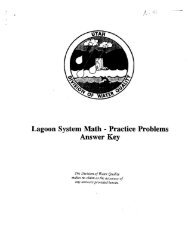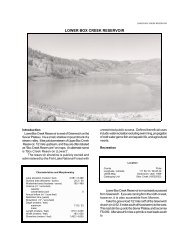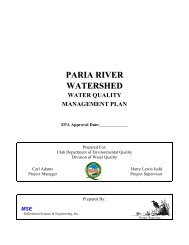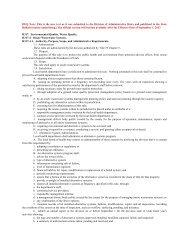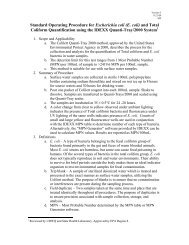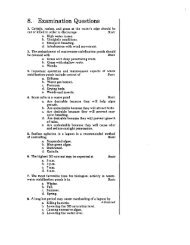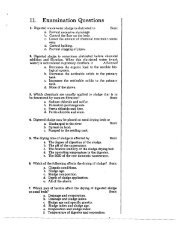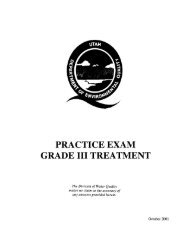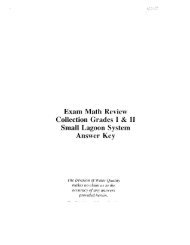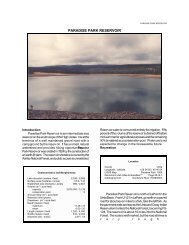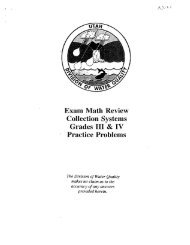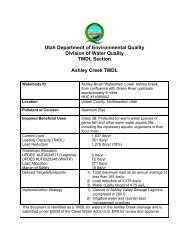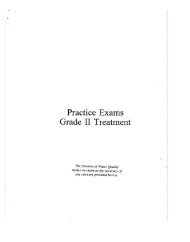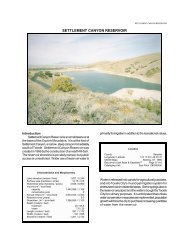Aquifer Recharge, Storage, and Recovery - Southwest Hydrology ...
Aquifer Recharge, Storage, and Recovery - Southwest Hydrology ...
Aquifer Recharge, Storage, and Recovery - Southwest Hydrology ...
- No tags were found...
Create successful ePaper yourself
Turn your PDF publications into a flip-book with our unique Google optimized e-Paper software.
Hydrogeology <strong>and</strong> ASR DesignGreg Bushner – Vidler Water CompanyToday there are many choicesfor the design <strong>and</strong> operation ofan aquifer storage <strong>and</strong> recovery(ASR) facility, since such facilitiescan serve a variety of needs. An ASRfacility has the capability to recharge,store, <strong>and</strong> recover all or a portion of thesource water recharged regardless ofthe recharge method. It might consistof shallow or deep infiltration basins,vadose zone wells, direct injection wells,wells that can both inject <strong>and</strong> recoverwater, or a combination thereof.Evaluating L<strong>and</strong> <strong>and</strong> WaterThe selection of a facility initially isdriven by the available source water,available or needed l<strong>and</strong>, <strong>and</strong> theplanned end use of the water. What isthe source water? It may be wastewatereffluent, seasonal surface water, vested orcertificated water rights, or another watersource. Once identified, its chemistrymust be evaluated to determine if itwill need pretreatment or if the qualityis adequate for the project method.Next, how much l<strong>and</strong> is needed <strong>and</strong> ofwhat type? A vadose zone, injection,or dual-use (recharge/recovery) wellin an urban setting has a significantlysmaller footprint than an infiltrationbasin; however, the unit l<strong>and</strong> costmay be much higher. How will thefacility design be incorporated into theavailable l<strong>and</strong> or vice versa? Is the l<strong>and</strong>undeveloped or has it been disturbed?Finally, what is the end use of thestored water—what type of recharge/recovery cycle will be needed?How long will the water be storedbefore it is recovered, <strong>and</strong> howwill it be accounted for untilit is recovered? Answeringthese questions will guidethe project design <strong>and</strong>budget through thenext phases of projectplanning. A life-cycle cost analysis isalso useful to determine the appropriaterecharge method <strong>and</strong> its application toa specific project <strong>and</strong> water source.Now the HydrogeologyNo matter what type of recharge methodis decided upon, all ASR projects requirecharacterization of the hydrogeologicconditions in the vicinity of the projectsite. This begins with identifying thel<strong>and</strong> use <strong>and</strong> l<strong>and</strong> owners, <strong>and</strong> anyexisting wells <strong>and</strong> their use, proximityto the project site, water source,conveyance options, <strong>and</strong> water quality.Baseline hydrologic data are critical topredict future impacts from the project.These data should include a water-levelelevationcontour map showing directionof groundwater flow <strong>and</strong> hydraulicgradient, <strong>and</strong> determination of storagecapacity or transit capacity of the vadosezone. Are water levels at surrounding wellsincreasing, decreasing, or both? Areasof subsidence should be mapped relativeto the project location. Baselinegroundwater chemistry data should becollected if they are not already available,<strong>and</strong> constructing one or more projectmonitoring wells may be warranted.Data NeedsDepending on the type of recharge methodto be used, additional hydrogeologicdata may be needed. Infiltration basinfacilities require a detailed investigationof the surficial soils <strong>and</strong> vadose zone.Soil samples should be analyzed forlithologic characteristics such as grainsize, distribution, intrinsic permeability,residual moisture content, <strong>and</strong> pore-waterchemistry. A similar investigation shouldbe conducted in the vadose zone throughuse of soil borings strategically locatedto represent site conditions for the projectarea. The goal of this investigation is toidentify positive attributes of the soils <strong>and</strong>vadose zone, such as high porosity <strong>and</strong>permeability that would be conducive fora particular recharge method, as well asnegative attributes such as the presenceof subsurface impermeable layers orAerial view of the Vidler <strong>Recharge</strong> Facility, aprivately-owned project in western Arizona thatcontains over 460 acres of surface infiltration basins.Photo: Kenney Aerial18 • May/June 2008 • <strong>Southwest</strong> <strong>Hydrology</strong>



